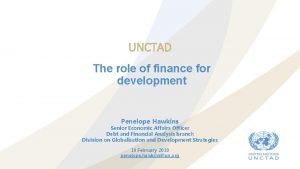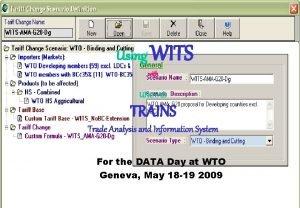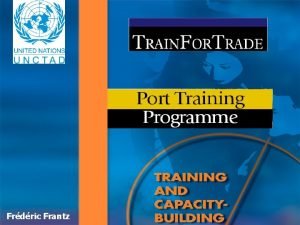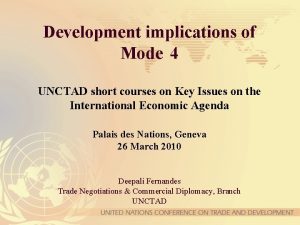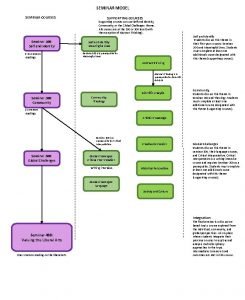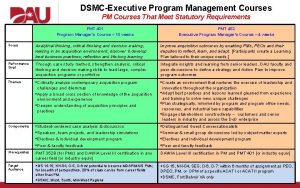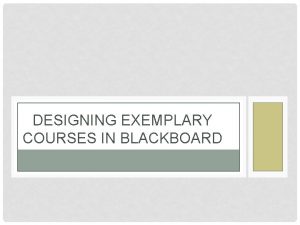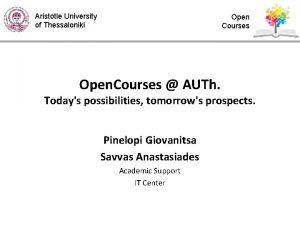UNCTAD Short Courses on Key Issues on the








































- Slides: 40

UNCTAD Short Courses on Key Issues on the International Economic Agenda for Permanent Missions in Geneva, Monday 23 April 2007 Promoting growth and development through ICTs Session II: ICT Strategies for Development: Key elements Cécile Barayre Marta Pérez Cusó ICT and E-Business Branch, SITE

Presentation outline A. Design of national ICT strategy B. Implementation and institutional framework C. Review and evaluation

A. Design of national ICT strategy

National ICT Strategies: main objectives • Raise awareness about the role of ICT for development, its benefits and requirements • Create an enabling environment for the adoption of ICT: access, regulations, incentives, payments… • Build capacity & skills for the information economy

National ICT policy framework Source: UNCTAD (2003) E-Commerce and Development Report

Basic elements of an ICT policy framework 1. 2. 3. 4. 5. 6. 7. ICT infrastructure, connectivity and access Legal and regulatory framework ICT human resources and skills Business development ICT-related trade and investment policies E-government Technological innovation (R&D)

1. ICT infrastructure, connectivity & access • ICT infrastructure: –Accessible, affordable, good quality –Costly: promote appropriate investment climate –Deployment of broadband • Create universal access to minimize digital exclusion –Shared access models –Universal service obligations –Public-private partnerships • Appropriate technologies (Hardware & Software)

What is FOSS? Free and Open-Source Software: a software which has its source code open • Free as in freedom Social movement. Four freedoms: 0. - Freedom to run it 1. - Freedom to study & modify it 2. - Freedom to redistribute copies 3. - Freedom to publish a modified version • Open-Source Software Practical solution, development methodology

Free and Open Source software • Consider adopting FOSS to contribute to the narrowing of the digital divide • Governments important role as designers of policies on technologies and as a de-facto market • Human resources development & training on FOSS

2. Legal and regulatory framework • Telecom regulation • Investment regulation • E-commerce laws • E-payment • Taxation • Trade policies (see session 3)

3. Human resources and skills • ICT skills in primary and secondary education • IT graduates and programs (Universities) • Training projects (public and private sectors)

IT education in Chile Red Enlaces (‘Network links’) • Launch 1992: 12 schools • By 2005: +9400 schools in rural and urban areas • Continuous effort: introducing broadband Source: Red enlaces www. enlaces. cl, UNCTAD (2003)

4. Business development • Promote the use of ICTs by enterprises • SME capacity building and finance (venture capital) • Create local content • Public procurement • Online tools (e-marketplaces)

Example: Grameen phone • 10 million mobile phone subscribers • Village Phone Program Source: grameenphone. com, tudakozo. vodafone. hu, UNCTAD (2006)

5. ICT-related trade and investment policies • Increase trade in ICT goods and services • Attract FDI • Promote ICT-related activities (e. g. outsourcing/offshoring)

Smart village: an Egyptian initiative • State-of-the-art infrastructure: – High-speed connectivity for integrated services (data, audio and video) • Customers: – Multinationals (Microsoft, Alcatel, Vodafone, HP and Ericsson) – Technology incubators & SMEs – MCIT and NTRA moved in Dec. 2004 as Phase II. – A financial district in Phase III (2006 -2007) for the Egyptian and Arab Stock Exchanges and other financial institutions • A high-tech business park: – Over 300 Acres of land (90% are green areas) – Hosting 54 buildings (336 000 sq. m. of office space) – Hosting 25, 000 – 30, 000 jobs

6. E-government Three main roles for Governments: • Users of ICT • Facilitators • Leaders

Steps to e-government Source: Finland Government (2003) as cited by UNCTAD (2004) E-Commerce & Development Report 2004

Some figures on e-government in 2005 • 179 of 191 member states had a website • 88 % of all countries provided info online • Only 1/3 of all countries provided public services online Serious access-divide Source: UNDESA, 2005

7. Technological innovation • Develop capacities through research and development programmes • Provide incentives to private sector investment in R&D

Designing and implementing ICT policies Key questions • How will the implementation of the strategy be organized and coordinated? • Who are the main partners and stakeholders involved in the implementation process? • Which policy areas should be given priority over others re: resources? • What institutional aspects need to be taken into consideration?

Designing and implementing ICT policies Lessons learned - successful ICT policies need: • • Leadership from the top (head of state) Involve all stakeholders in implementation A holistic approach covering all sectors A liberalized economic environment Monitoring of ICT developments Tailoring towards countries’ requirements Mainstreaming ICTs into national economic and social development plan

B. Implementation and institutional framework • Promoting pro-poor policies • Measuring and monitoring: ICT indicators and ICT policy review

Pro-poor ICT Strategies ICTs for Development vs. Pro-poor ICTs Poverty = multiple deprivation

Pro-poor ICTs: Current thinking • ICTs a tool for poverty, necessary but insufficient • Different technologies contribute differently • Embed pro-poor ICT efforts in poverty reduction initiatives • Ensure impact by scaling-up projects • Support needed at all levels • Promote research focused on pro-poor ICTs

Pro-poor ICTs: Institutional barriers • Cross-cutting nature of ICTs for poverty reduction • Working with others is not easy • Limited quantitative & qualitative assessments • Scaling-up: + than replicating good projects • Limited incentives to coordinate strategies • Power imbalances

UNCTAD’s Pro-poor ICT framework 12 Conn Conte Com Capa Cultu Coop Capit Conte Conti Contr Coher xt nuity ol ence Cs ectivit nt munit merce city re eratio al y Macro Meso Micro Visio n Assu mptio ns Confli cts y n

The 12 C’s Connectivi ty • Accessible & affordable Infrastructure & technology Cooperati on • All stakeholders support the initiative Content • Relevant & accessible • Users participate in its development Capital • Financial sustainability Communit y Commerce • Provile & level of participation of users Context • Adapted to context • Influences context • Supports economic activities & livelihoods Continuity • Monitoring & evaluation • Flexible promotes learning Capacity • User’s capacity • Organisation’s capacity Control • Beneficiaries’ ownership • Stakeholders accountable • Supportive culture • Coherent with other

Measuring and monitoring • Statistical data critical for policy makers • What to measure? Access, use & impact • Data available: statistics & estimates/surveys for OECD countries - limited for developing countries • Global initiative: Partnership on measuring ICT 4 D. Members: ITU, OECD, UNCTAD, UNESCO, Institute for Statistics (UN ICT Task Force GAID), World Bank, ECA, ECLAC, ESCAP, ESCWA, Eurostat

ICT growth in Egypt • Investment of ICT Companies in Egypt exceeded USD 6 billion over past 8 years • Increase in number of ICT companies to 1920 • Current Number of Employees of private ICT companies exceeds 45, 000

Closing the data gap in developing countries Source: UNCTAD (2006)

C. Review and evaluation

National ICT plans in developing and transition countries and territories (2006) No information available Country in the process of developing a national ICT Strategy Country with a national ICT Strategy Source: UNCTAD (2006)

UNCTAD survey on ICT master plans How many developing countries have adopted an ICT strategy or master plan? • 181 developing and transition countries and territories surveyed (UNCTAD 2006) • 80 (44%) have adopted an ICT plan • 36 (20%) are designing an ICT plan • ICTs: part of many developing countries' development plans and poverty reduction strategies

Example: Rwanda Strategy Implementation National ICT plan RITA – Rwanda Information Technology Authority NICI‘ 01 -’ 05 included Human resources development Human Resource Development Agency Training of civil servants ICT in higher learning Promotion of women in ICT PCs in schools & train IT teachers Evaluation Some progress: PCs now in 1138 schools Still challenges: Only 26% of the plan achieved Major cause Lack of qualified human resources

The way ahead: ICT policy reviews • National ICT plans exist in many developing countries • Need to assess and evaluate policies • ICT monitoring and measurement • UNCTAD: ICT policy review framework for the information economy

UNCTAD ICT policy review model framework ICT environment ICT infrastructure & access § Access to & use of ICTs by households and individuals § Use of ICTs by businesses § ICT sector and trade in ICT goods § Other ICT indicators § Objectives and priority areas & strategic approach § ICT infrastructure development § Legal and regulatory framework § ICT human resources/skills § Business development § ICT-related trade & investment policies § E-government § Technological innovation (R&D) § ICT uptake and use indicators Implementation & Institutional framework ICT policy framework Integration of ICT policies in national development plans /PRSP § Institutional setup for implementation of ICT plan § Policy coordination § Financial resources § Monitoring and evaluation § Indicators of achievement – identification of success factors, best practices, lessons learnt and challenges ahead Policy recommendations Revised ICT master plan/policies Source: UNCTAD (2006) Transparent and continuous consultation process with all stakeholders Assessment of existing ICT master plan

UNCTAD ICT policy review model framework • Generic model > could be used as a basis by developing countries • Adapted to the needs of each country • Could include additional elements to reflect specific national aspects not covered by the model

Conclusion National ICT Strategies: • Promote infrastructure, connectivity and access • Build human competence • Adequate legal and regulatory framework • Business sector policies • E-government • Technology and innovation • Carry out periodic ICT policy reviews – role of ICT indicators

Thank you for your attention Any questions or comments? www. unctad. org/ecommerce measuring-ict. unctad. org susan. teltscher@unctad. org
 Tall + short h
Tall + short h Penelope hawkins
Penelope hawkins Bnl itd
Bnl itd Unctad trains
Unctad trains Unctad objetivos
Unctad objetivos Biust short courses
Biust short courses Unsw art and design short courses
Unsw art and design short courses Survey methodology phd programs
Survey methodology phd programs Cost structure example business model canvas
Cost structure example business model canvas Key partners
Key partners Hát kết hợp bộ gõ cơ thể
Hát kết hợp bộ gõ cơ thể Bổ thể
Bổ thể Tỉ lệ cơ thể trẻ em
Tỉ lệ cơ thể trẻ em Gấu đi như thế nào
Gấu đi như thế nào Glasgow thang điểm
Glasgow thang điểm Hát lên người ơi
Hát lên người ơi Kể tên các môn thể thao
Kể tên các môn thể thao Thế nào là hệ số cao nhất
Thế nào là hệ số cao nhất Các châu lục và đại dương trên thế giới
Các châu lục và đại dương trên thế giới Công thức tiính động năng
Công thức tiính động năng Trời xanh đây là của chúng ta thể thơ
Trời xanh đây là của chúng ta thể thơ Cách giải mật thư tọa độ
Cách giải mật thư tọa độ Phép trừ bù
Phép trừ bù độ dài liên kết
độ dài liên kết Các châu lục và đại dương trên thế giới
Các châu lục và đại dương trên thế giới Thể thơ truyền thống
Thể thơ truyền thống Quá trình desamine hóa có thể tạo ra
Quá trình desamine hóa có thể tạo ra Một số thể thơ truyền thống
Một số thể thơ truyền thống Cái miệng xinh xinh thế chỉ nói điều hay thôi
Cái miệng xinh xinh thế chỉ nói điều hay thôi Vẽ hình chiếu vuông góc của vật thể sau
Vẽ hình chiếu vuông góc của vật thể sau Biện pháp chống mỏi cơ
Biện pháp chống mỏi cơ đặc điểm cơ thể của người tối cổ
đặc điểm cơ thể của người tối cổ V. c c
V. c c Vẽ hình chiếu đứng bằng cạnh của vật thể
Vẽ hình chiếu đứng bằng cạnh của vật thể Tia chieu sa te
Tia chieu sa te Thẻ vin
Thẻ vin đại từ thay thế
đại từ thay thế điện thế nghỉ
điện thế nghỉ Tư thế ngồi viết
Tư thế ngồi viết Diễn thế sinh thái là
Diễn thế sinh thái là

